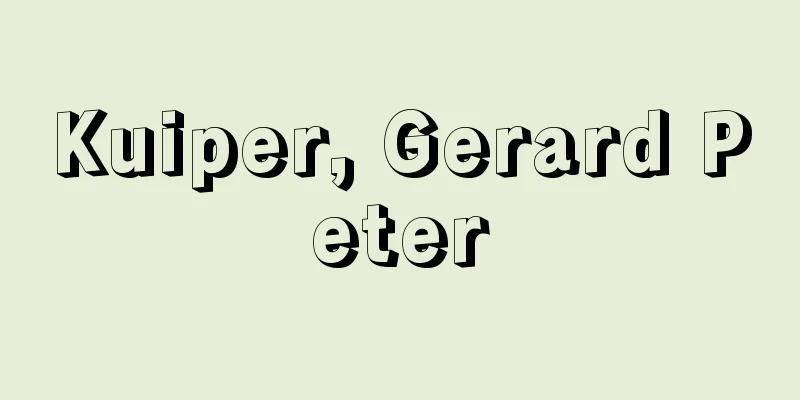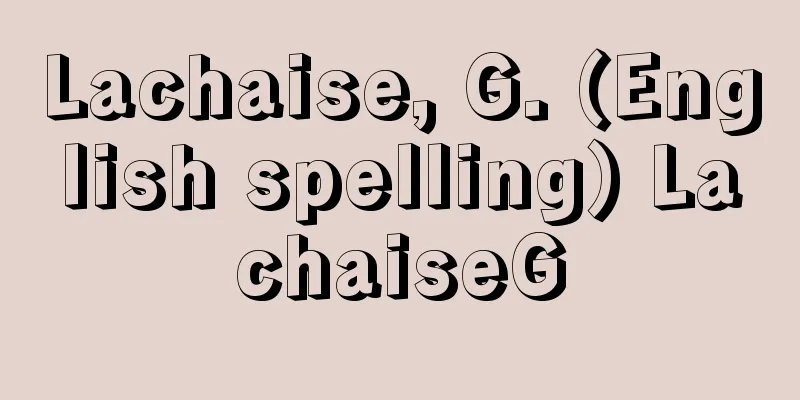Elementary particle - Soryushi (English spelling) elementary particle

|
The most basic building blocks of matter in the natural world are called elementary particles. In the microscopic world, elementary particles are repeatedly created and destroyed according to the laws of quantum mechanics and relativity. Basic components and hierarchical structureThe history of natural philosophers' exploration of the fundamental elements of matter began in ancient Greece. Democritus named the fundamental components of matter "atoms," meaning that they cannot be divided. After many years, the development of chemistry in the 19th century led to the discovery of atoms as the basic components of matter that do not change during chemical reactions. Later, with the development of physics, it became clear that atoms are made up of nuclei and electrons, that nuclei are made up of protons and neutrons, and that protons and neutrons, or nucleons, are made up of quarks. In this way, matter has a hierarchical structure, and the basic components have changed over time. Currently, quarks that form hadrons and leptons (light particles) that are related to electrons are the basic particles that are the basis of matter, and together with the gauge particles that mediate the forces between them, these are "elementary particles" in the original sense of the word. In other words, protons, neutrons, and even the π (pi) meson, which mediates nuclear forces in Hideki Yukawa's meson theory, are composite particles made of quarks and their antiparticles, antiquarks, and are therefore no longer "elementary particles." However, since protons, neutrons, electrons, and photons have been called elementary particles since the 1930s, they are often conventionally included in the category of elementary particles. [Tsuneo Uematsu] Classification of elementary particlesElementary particles are classified, first according to the nature of their interactions, into hadrons, which are related to nucleons and π mesons that have strong interactions, leptons, which are related to electrons that do not have strong interactions, and gauge particles, which mediate interactions. On the other hand, elementary particles are broadly divided into two types: bosons, which have an integer spin (units of Planck's constant h divided by 2π), and fermions, which have a half-integer spin. The quarks and electrons that make up hadrons have a spin of 1/2 and are fermions, while gauge particles have a spin of 1 and are bosons. Fermions follow Fermi-Dirac statistics, which state that only one fermion can be in the same state, while bosons follow Bose-Einstein statistics, which state that any number of bosons can be in the same state. [Tsuneo Uematsu] From hadrons to quarksParticles that have strong interactions, such as nucleons and π mesons, are called hadrons. Hadrons are broadly divided into baryons (heavy particles) which are related to nucleons, and mesons (mesons) which are related to π mesons. When they were first discovered in the mid-20th century, hadrons were thought to be fundamental particles, but after several hundred types of particles were discovered in accelerator experiments, hadrons came to be thought of as composites of more fundamental particles. Among nucleons, the Λ (lambda) particle, which has a quantum number called strangeness, was found in cosmic rays, and Nakano Tadao (1926-2004), Nishijima Kazuhiko, and M. Gell-Mann discovered the Nakano-Nishijima-Gell-Mann rule (NNG rule), which links this new quantum number with baryon number, isospin, and charge. Sakata Shoichi proposed the composite model, known as the Sakata model, which states that hadrons are composed of the proton (p), neutron (n), and Λ particle (Λ), which were known at the time, as fundamental particles, and their antiparticles. That is, the proton and neutron carry the third component of isospin ±1/2, and the Λ particle carries strangeness, which explains the above NNG rule and the structure of the set of eight particles (octet) of mesons, and the fact that the composite system made up of these three elements has the symmetry of the three-dimensional unitary group (SU(3) group) was discovered by three scientists, Mineo Ikeda (1926-1983), Yoshio Onuki (1928-), Shuzo Ogawa (1924-2005), and Yoshio Yamaguchi (1926-2016). However, the Sakata model could not explain the set of eight baryons. Seeing the difficulties of this model, Gell-Mann and George Zweig (1937- ) independently introduced new particles u, d, and s (Gell-Mann called them "quarks" and Zweig called them "aces", but quark became the accepted name) that are fundamental particles and proposed the quark model, which describes hadrons as composite states of these and their antiparticles. The charges of these particles are 2/3 for the u quark, -1/3 for the d quark, and -1/3 for the s quark, with the unit of elementary charge e. The third component of isospin is given as 1/2 and -1/2 for u and d, respectively, and zero for the s quark, and strangeness is given as zero for u and d, and -1 for s. As shown in , baryons, which are related to nucleons and Λ particles, are composed of three quarks. In general, if q represents a quark, baryons can be written as B~(qqq). For example, the proton is p~ (uud), the neutron is n~ (udd), and the Λ particle is Λ~ (uds). The meson M, which is a member of the π meson and K meson family, is composed of a quark q and an antiquark, and can be expressed as M~ (q). For example, π + ~ (u), π - ~ (dū), and K + ~ (u). The quark model predicted the existence of a decaplet of 10 baryons, and one of them, the Ω-particle ~ (sss) with strangeness -3, was discovered in an experiment, which was a great success. [Tsuneo Uematsu] quarkCurrently, six types of quarks are known, including the aforementioned u (up), d (down), and s (strange), as well as the three heavier types c (charm), b (bottom), and t (top). These are called the six flavors of quarks. In addition, as proposed by Yoichiro Nambu et al. based on the consistency of fermion spin and statistics, each quark has three internal degrees of freedom called color (color charge): red, blue, and green. The colors of the three quarks that make up a nucleon are red, blue, and green, and when they mix together they become colorless, and the color charge does not appear outside. Mesons also become colorless between the three color charges of a quark and its antiquark's opposite color, antired, antiblue, and antigreen, and the color does not appear outside. Experiments have not found fractional charges such as 2/3 times the elementary charge. In other words, quarks cannot come out by themselves. This is called quark confinement. Meanwhile, with regard to the aforementioned flavors of quarks, Makoto Kobayashi and Toshihide Maskawa pointed out in 1973 that six or more types of quarks were needed to explain the observed asymmetry between matter and antimatter (violation of CP symmetry). The top quark, which remained undiscovered until the very end, was discovered in 1995 in a proton-antiproton collision experiment at the Fermi National Accelerator Laboratory in the United States ( ). [Tsuneo Uematsu] LeptonsParticles that do not interact with the strong force and are related to the electron, which together with quarks makes up matter, are called leptons (light particles). Leptons interact with the weak force and the electromagnetic force. They consist of the electron e, the muon μ, the tau particle τ, and the associated neutrinos (ν e , ν μ , ν τ ). They are divided into three generations as follows: First generation: electron (e), electron neutrino (ν e ), and their antiparticles Second generation: muon (μ), muon neutrino (ν μ ), and their antiparticles Third generation: tau particle (τ), tau neutrino (ν τ ), and their antiparticles As shown in Table 1, quarks and leptons each consist of a pair of two particles. The existence of the charm quark (c) was first predicted by Jiro Maki (1929-2005) and Yasuo Hara (1934- ) based on this correspondence between quarks and leptons. Just as quarks mix with each other, neutrinos also mix between generations due to their mass, a phenomenon known as neutrino oscillation. [Tsuneo Uematsu] Basic InteractionsThere are four fundamental interactions (forces) in nature: strong, weak, electromagnetic, and gravity. The strong force binds quarks together to form hadrons, and is mediated by gluons. The weak force governs beta decay of atomic nuclei and nuclear fusion within the nucleus, and is mediated by weak bosons. Electromagnetic force binds electrons and nuclei to form atoms, and is mediated by photons. Gravity is also called the gravitational force, and is mediated by gravitons associated with gravitational fields. The relative strengths of the fundamental interactions at a distance of 10 -15 m are approximately strong:electromagnetic:weak:gravitational = 1:10 -2 :10 -5 :10 -39 ( ). [Tsuneo Uematsu] Gauge particleA particle that mediates interactions between fundamental particles and is associated with a gauge field in the gauge theory that forms the basis of the Standard Model ( ). [Tsuneo Uematsu] GluonGluons are electrically neutral particles with a spin of 1. While quarks have three color charges, gluons have eight color charges, and their exchange generates the strong force. The theory that explains this is quantum chromodynamics (QCD). A characteristic of this force is that it becomes weaker the closer the quarks are to each other, and conversely, the farther apart they are, the stronger it becomes. This property is called asymptotic freedom. This explains why quarks and gluons, which have color, cannot escape by themselves. This is called the confinement of quarks and gluons. [Tsuneo Uematsu] photonA particle that appears when an electromagnetic field is quantized, also known as a photon. It has zero mass and a spin of 1. Quantum electrodynamics (QED), which describes the interaction between electrons and photons, explains experimental facts with extremely high precision by processing infinite quantities through an operation called renormalization of perturbation theory, which is expanded with the fine structure constant α = 1/137, which is a coupling constant. R. Feynman, J. Schwinger, and Shinichiro Tomonaga were awarded the Nobel Prize for their contributions to the development of this theory. [Tsuneo Uematsu] Weak BosonThere are three types of spin-1 bosons that mediate the weak interaction: W ± , with a charge of ±1, and Z 0 , with a mass of 80.4 gigaelectronvolts (GeV) and 91.2 GeV, respectively. These vector bosons acquire mass by absorbing massless scalar particles (Nambu-Goldstone particles) that appear in spontaneous symmetry breaking (described below) into the longitudinal component of the vector field. [Tsuneo Uematsu] GravitonA particle that mediates gravitational interactions, also known as a graviton. It is a particle with zero mass and spin of 2. Just as photons appear as quanta associated with an electromagnetic field when quantum mechanics is applied, gravitons appear when a gravitational field is quantized. They have not yet been found in an experiment. [Tsuneo Uematsu] Spontaneous symmetry breakingA system of elementary particles has the characteristic that its properties remain unchanged under certain transformations. This is called symmetry. For example, in the theory of relativity, when the laws of motion remain unchanged under Lorentz transformations between inertial frames, it is said to have Lorentz symmetry. Also, when a theory remains unchanged under gauge transformations such as the electromagnetic field, it is said to have gauge symmetry. If a system with a certain symmetry no longer holds when it transitions to the lowest energy state, i.e., a vacuum, then spontaneous symmetry breaking occurs. For example, in ferromagnetic materials such as iron and nickel, when the temperature is lowered, the spin direction, or in other words the direction of the magnetic moment, aligns without the application of an external magnetic field, so-called spontaneous magnetization occurs. This corresponds to the spontaneous breaking of rotational symmetry, which means that the properties do not change even when the system is rotated. Yoichiro Nambu and Giovanni Jona-Lasinio (1932- ) proposed a model in which chiral symmetry, a symmetry that independently transforms the right-handed and left-handed components of spin-1/2 fermions into different flavor directions, is broken spontaneously. This breaking explains the mass of the nucleon, and at the same time, a boson with zero mass and zero spin appears. This is called the Nambu-Goldstone boson. The π meson is thought to be approximately such a boson. [Tsuneo Uematsu] Higgs particleThe Higgs boson is the particle that gives mass to elementary particles in the Standard Model. When this particle field, i.e. the Higgs field, condenses into a vacuum due to spontaneous symmetry breaking, each elementary particle acquires mass according to the strength of its coupling with the Higgs boson. Figuratively speaking, when elementary particles pass through a space filled with Higgs, they are resisted and gain mass. W bosons and Z bosons have zero mass if gauge symmetry is not broken, but they gain mass when symmetry is broken spontaneously. Quarks and leptons also gain mass through Yukawa coupling with the Higgs boson. This mechanism was proposed by Peter Higgs in 1964, so it is called the "Higgs mechanism." A similar theory was independently proposed by F. Englert and R. Braut a month or two earlier in the same year. G.S. Guralnick, C.R. Hagen, and T.W.B. Kibble also published similar theories a little later. In July 2012, the ATLAS and CMS experimental groups reported the discovery of a new boson believed to be the Higgs boson with a mass of around 125 GeV at the Large Hadron Collider (LHC) at CERN. In March 2013, through further analysis, the two groups reported detailed results on the decay mode of this particle, and confirmed that it has zero spin and positive parity, strongly suggesting that it is the Higgs boson of the Standard Model. In October of the same year, it was announced that the Nobel Prize in Physics would be awarded to both Dr. Higgs and Dr. Englert (Dr. Braut died in 2011). [Tsuneo Uematsu] CP violationCP symmetry refers to the symmetry that does not change the properties of a system when a charge conjugation transformation (C transformation), which inverts the sign of the charge in the system, and a parity transformation (P transformation), which inverts the space, i.e., swaps the right-handed system and the left-handed system, are performed simultaneously, i.e., CP transformation. Since CP transformation swaps matter and antimatter, if CP symmetry is violated, matter and antimatter will behave differently. In 1973, Makoto Kobayashi and Toshihide Maskawa proposed the theory of CP violation, which showed that if there are six or more flavors of quarks, a complex phase appears in the CKM matrix, which represents the mixing of quarks, and CP symmetry violation can occur. In 2001, the Belle experiment at the High Energy Accelerator Research Organization (KEK) B Factory, which aimed to verify this theory, obtained experimental results showing CP symmetry violation. Similar results were also confirmed by the BaBar experiment at the Stanford Accelerator Center in the United States. [Tsuneo Uematsu] SupersymmetryThis symmetry connects bosons and fermions, and is called supersymmetry. In nature, there are bosons with integer spins and fermions with half-integer spins. Quarks and leptons are fermions with spin 1/2, while the gauge particles that mediate the weak, electromagnetic, and strong interactions are bosons with spin 1. The graviton is a boson with spin 2. The degree of divergence in quantum effects in the high-energy region of quantum field theory is characterized by a tendency for fermions and bosons to cancel each other out and weaken. This symmetry is considered to play an important role in the unification theory of forces, explaining the large scale gap between 10 19 GeV, where the quantum effects of gravity become problematic, and 10 2 GeV, where the weak and electromagnetic interactions are unified, the so-called gauge hierarchy problem. This symmetry means that existing particles have companion particles with spins that differ by 1/2. That is, among quarks and leptons, there are squarks and sleptons with spin zero, and among gauge particles with spin 1, there are supersymmetric particles with spin 1/2. Supersymmetric particles have not been discovered in the real low-energy world, and are thought to have a larger mass than the original particles, and searches for them are being conducted at accelerators such as the LHC. [Tsuneo Uematsu] Unified theory of interactionsThe four fundamental interactions in nature appear different at low energies, but at very high energies they have the same strength and are thought to be essentially unified into one theory. The weak and electromagnetic forces have already been unified into a unified theory based on the SU(2)×U(1) group by Glashow-Weinberg-Salam. This unified theory and the QCD theory for the strong force based on the SU(3) gauge group are collectively called the Standard Model. It is expected that the strong force, weak and electromagnetic forces will be unified into a Grand Unified Theory (GUT) at very high energies of 10 15 to 10 16 gigaelectronvolts (GeV). Furthermore, the "Superstring Theory" that unifies the four fundamental forces, including gravity, is currently being pursued. [Tsuneo Uematsu] "The Quest for Elementary Particles: Standing in the Field of Truth" by Yukawa Hideki, Sakata Shoichi, and Takeya Mitsuo (1965, Keiso Shobo)" ▽ "Weak Interactions of Elementary Particles" edited by Konuma Michiji and Nakagawa Masami (1972, Physical Society of Japan)" ▽ "Composite Models of Elementary Particles" by Ogawa Shuzo, Sawada Shoji, and Nakagawa Masami (1980, Iwanami Shoten)" ▽ "Towards a Unified Theory of Elementary Particles" by Nishijima Kazuhiko (1995, Iwanami Shoten) ▽ "Elementary Particle Physics" by Maki Jiro and Hayashi Koichi (1995, Maruzen)" ▽ "Quarks: How Far Have Elementary Particle Physics Proved? Second Edition by Nambu Yoichiro (1998, Kodansha)" ▽ "The Missing Antimatter: The Mystery of the Evolution of the Universe Solved by Elementary Particle Physics" by Kobayashi Makoto (1997, Kodansha)" ▽ "Another Introduction to Elementary Particle Physics," edited by the Parity Editorial Committee and Yoshihiko Otsuki, written by Toshihide Maskawa (1998, Maruzen)" ▽ "The Fundamentals of Elementary Particle Physics," written by Junsei Nagashima, 2 volumes (1998, Asakura Shoten)" ▽ "Elementary Particle Physics," written by Yasuo Hara, Takeo Inami, and Kenichiro Aoki (2000, Asakura Shoten)" ▽ "Elementary Particle Physics," written by Yoji Tozuka (2000, Iwanami Shoten)" ▽ "Introduction to Elementary Particle Physics -- From Basic Concepts to the Cutting Edge," written by Yasushi Watanabe (2002, Baifukan)" ▽ "Elementary Particle Physics," written by Yasuo Hara (2003, Shokabo)" ▽ "History of Modern Physics 1: Elementary Particles, Atomic Nuclei, and the Universe," edited by the Asakura Physics Series Editorial Committee (2004, Asakura Shoten)" ▽ " Iwanami Lecture Series on Physics: The World of Physics: Elementary Particles and Space-Time 5," written by Toru Eguchi and Yosuke Imamura Superstring Theory of Elementary Particles (2005, Iwanami Shoten)'' ▽ ``The Mystery of Quarks: Mysteries and Revolutions in Elementary Particle Physics, by R.M. Barnett, H. Muley, and H.R. Quinn, translated by Moriya Masayo (2005, Springer-Verlag Tokyo)' ' ▽ ``Matter, Elementary Particles, and the Universe Viewed from Symmetry: From the Mystery of Mirrors to Supersymmetry Theory, by Hirose Tatsunari (2006, Kodansha)'' ▽ ``Elementary Particle Physics, by Aihara Hiroaki (2006, University of Tokyo Press)'' ▽ ` `Opening up the World of Elementary Particles: The People and Times of Yukawa Hideki and Tomonaga Shin'ichiro, edited by the Yukawa and Tomonaga Centennial Exhibition Committee and supervised by Sato Fumitaka (2006, Kyoto University Press)'' ▽ ``Is there an end to the universe? --The history of the universe revealed by elementary particles (2010, NanoOptics Energy Publishing Bureau)" ▽ "Creating a small universe -- The simplest story about elementary particles and the universe" by Junpei Fujimoto (2012, Gentosha Education)" ▽ "Elementary Particles, 2nd Edition (Iwanami Shinsho) by Hideki Yukawa, Yasuhisa Katayama, and Hideo Fukudome" Elementary Particles, 2nd Edition (Iwanami Shinsho )" ▽ "Elementary Particles and the Laws of Physics -- In Search of the Ultimate Laws of Physics" by Richard P. Feynman and Steven Weinberg, translated by Tetsuro Kobayashi (Chikuma Gakugei Bunko)" ▽ "What is the universe made of? --Unravelling the mysteries of the universe through elementary particle physics" by Hitoshi Murayama (Gentosha Shinsho)" ▽ "What is gravity? --From Einstein to superstring theory, approaching the mysteries of the universe" by Hiroshi Oguri (Gentosha Shinsho)" [References] | | | | | | | | | | | | | | | | | | | | | | | | | | | | | | | | | | |©Shogakukan "> Quark composition of baryons and mesons (diagram) ©Shogakukan "> Quarks and leptons that make up matter (Table 1) ©Shogakukan "> Four basic interactions (Table 2) ©Shogakukan "> Gauge particles that transmit forces (Table 3) Source: Shogakukan Encyclopedia Nipponica About Encyclopedia Nipponica Information | Legend |
|
自然界の物質を構成するもっとも基本的な構成要素を素粒子という。ミクロの世界では量子力学と相対論の法則に従って、素粒子は互いに生成・消滅をくり返している。 基本構成要素と階層構造古代ギリシアの時代から、自然哲学者たちによる物質の根源的な要素の探究の歴史は始まっていた。デモクリトスは、物質の根源的な構成要素を、分割できないものという意味で「アトム(原子)」と名づけた。その後長い年月を経て、19世紀の化学の発展により、物質の化学反応で変化しない基本構成要素として原子(Atom)がみいだされた。さらにその後、物理学の発展とともに、原子は原子核と電子から、原子核は陽子と中性子からなり、さらに陽子や中性子すなわち核子はクォークからなることが明らかになった。このように物質は階層構造をなしており、基本構成要素は時代とともに変化してきた。現在では、ハドロンを形成するクォークや電子の仲間のレプトン(軽粒子)が物質の元となる基本的粒子であり、それらの間の力を媒介するゲージ粒子をあわせて、これらが言葉の本来の意味での「素粒子」である。すなわち、陽子や中性子さらに湯川秀樹の中間子論で核力を媒介するπ(パイ)中間子などはクォークおよびその反粒子である反クォークからなる複合粒子であるから、もはや「素粒子」ではないが、1930年代から陽子、中性子、電子、光子を素粒子とよんでいたこともあり、慣用的に素粒子の中に含められることが多い。 [植松恒夫] 素粒子の分類素粒子の分類は、まず相互作用の性質によると、強い相互作用をする核子やπ中間子の仲間であるハドロン、強い相互作用をしない電子の仲間のレプトン、相互作用を媒介するゲージ粒子に分けられる。 一方素粒子は、スピン(プランク定数hを2πで割った値を単位とする)が整数のものをボース粒子(ボソン)、半整数のものをフェルミ粒子(フェルミオン)の二つに大別される。 ハドロンを構成するクォークや電子はスピンが1/2でフェルミオンであり、ゲージ粒子はスピンが1でボソンである。フェルミオンは同じ状態には1個しか入れないというフェルミ‐ディラック統計に従うのに対し、ボソンは同じ状態に何個でも入りうるというボース‐アインシュタイン統計に従う。 [植松恒夫] ハドロンからクォークへ核子やπ中間子など強い相互作用を行う粒子をハドロンという。ハドロンは大別して、核子の仲間のバリオン(重粒子)とπ中間子の仲間のメソン(中間子)に分けられる。20世紀半ばに発見された当初、ハドロンは基本的な粒子と考えられたが、その後の加速器の実験で数百種類もの粒子が発見されて、ハドロンはより基本的な粒子の複合状態であると考えられるようになった。核子の仲間では宇宙線中にストレンジネスという量子数をもったΛ(ラムダ)粒子が見つかって、中野董夫(ただお)(1926―2004)、西島和彦、M・ゲルマンによる、この新たな量子数とバリオン数、アイソスピンおよび電荷を結ぶ規則いわゆる中野‐西島‐ゲルマン則(NNG則)が発見された。坂田昌一は当時知られていた陽子(p)、中性子(n)、Λ粒子(Λ)を基本粒子としてハドロンはそれらとその反粒子から構成されるという複合模型いわゆる坂田模型を提唱した。すなわち陽子と中性子がアイソスピン第3成分の±1/2を担い、Λ粒子がストレンジネスを担うことで、上記のNNG則や中間子の8個の粒子の組(オクテット)の構造を説明することができ、またこれら3要素がつくる複合系に3次元ユニタリー群(SU(3)群)の対称性があることが、池田峰夫(1926―1983)、大貫義郎(よしお)(1928― )、小川修三(1924―2005)の3名と山口嘉夫(1926―2016)によってみいだされた。しかし、坂田模型ではバリオンの8個の組を説明することができなかった。この模型の困難をみたゲルマンとツバイクGeorge Zweig(1937― )はそれぞれ独立に基本粒子をハドロンとは別の階層の新たな粒子(ゲルマンはそれらを「クォーク」と名づけ、ツバイクは「エース」とよんだが、クォークが定着した)u,d,sを導入し、これらとその反粒子の複合状態としてハドロンを説明するクォーク模型を提唱した。その電荷は、電気素量eを単位として、uクォークが2/3、dクォークが-1/3、sクォークが-1/3。アイソスピンの第3成分はu,dがそれぞれ1/2と-1/2、sクォークがゼロでストレンジネスはu,dがゼロ、sが-1と与えられる。のように、核子やΛ粒子の仲間のバリオンはクォーク三つで構成される。一般に、クォークをqで表すとバリオンはB~(qqq)と記すことができる。たとえば、陽子はp~(uud)、中性子はn~(udd)、またΛ粒子はΛ~(uds)である。またπ中間子、K中間子の仲間のメソンMはクォークqと反クォークからなり、M~(q)と表せる。たとえばπ+~(u)、π-~(dū)、K+~(u)である。クォーク模型はバリオンの10個組(デカプレット)の存在を予言し、そのなかのストレンジネス-3のΩ-粒子~(sss)が実験で見つかり、大きな成功を収めた。 [植松恒夫] クォーク現在ではクォークは前述のu(アップ)、d(ダウン)、s(ストレンジ)のほかに、これらより質量が重いc(チャーム)、b(ボトム)、t(トップ)の三つをあわせて6種類のクォークが知られている。これをクォークには六つのフレーバー(香り)があるという。また、フェルミオンのスピンと統計との整合性から南部陽一郎らによって提唱されたように、各クォークには、赤、青、緑の3種のカラー(色電荷)とよばれる内部自由度がある。核子を構成する三つのクォークのカラーは赤、青、緑でそれらが混じり合って無色となり、色電荷は外には現れない。中間子もクォークの3種の色電荷とその反クォークの反対色の反赤、反青、反緑の間で無色となってカラーは外に現れない。実験では素電荷の2/3倍といった分数電荷はみつかっていない。すなわち、クォークは単独では外に出てこない。これをクォークの閉じ込めという。一方、前述のクォークのフレーバーに関して、観測されている物質と反物質の非対称性(CP対称性の破れ)を説明するにはクォークが6種類以上必要であることを小林誠と益川敏英が1973年に指摘した。最後まで未発見であったトップ・クォークも1995年にアメリカのフェルミ国立加速器研究所の陽子・反陽子衝突の実験で見つかった()。 [植松恒夫] レプトン強い相互作用をしない粒子で、クォークとともに物質を構成する電子の仲間の粒子をレプトン(軽粒子)という。レプトンは弱い相互作用と電磁気相互作用を行う。電子e、ミュー粒子μ、タウ粒子τとそれらに付随したニュートリノ(νe、νμ、ντ)からなる。これらは以下のように3世代に分かれる。 第1世代 電子(e)、電子ニュートリノ(νe)、およびそれらの反粒子 [植松恒夫] 基本的相互作用自然界に存在する基本的な相互作用(力)は、強い力、弱い力、電磁気力、重力の四つと考えられている。強い力はクォークを結合させてハドロンを構成する力で、グルーオンによって媒介され、弱い力は原子核のベータ崩壊や構成内部の核融合をつかさどる力で、ウィークボソンによって媒介される。電磁気力は電子と原子核を結びつけて原子を形成する力で、光子(フォトン)によって媒介される。重力は万有引力ともよばれ、力を媒介するのは重力場に伴う重力子(グラビトン)である。基本的相互作用の相対的な強さは、10-15mの距離でおおよそ強:電磁:弱:重力=1:10-2:10-5:10-39である()。 [植松恒夫] ゲージ粒子基本粒子間の相互作用を媒介する粒子で、標準模型の基礎となるゲージ理論においてゲージ場に伴う粒子である()。 [植松恒夫] グルーオングルーオンは電気的に中性でスピンが1の粒子である。クォークが3色のカラー荷をもつのに対して、グルーオンは8色のカラー荷を有し、その交換によって強い力を生じる。これを説明する理論が量子色力学(QCD)である。その力の特徴はクォークがお互いに近づくほど弱くなり、逆に離れれば離れるほど強くなることである。この性質を漸近的自由性という。これにより、カラーをもったクォークやグルーオンは単独では外へ出てこられないことが理解される。これをクォークとグルーオンの閉じ込めという。 [植松恒夫] 光子電磁場を量子化したときに現れる粒子でフォトンともよばれる。質量がゼロ、スピンが1である。電子と光子の相互作用を記述する量子電気力学(QED)は結合定数である微細構造常数α=1/137で展開する摂動論のくりこみという操作で無限大の量を処理すると、極めて高い精度で実験事実を説明する。R・ファインマン、J・シュウィンガー、朝永振一郎はこの理論の発展に貢献した業績でノーベル賞を受賞した。 [植松恒夫] ウィークボソン弱い相互作用を媒介するスピン1のボソンで、電荷が±1のW±とゼロのZ0の3種類があり、質量はそれぞれ80.4ギガ電子ボルト(GeV)、91.2GeVである。これらのベクトルボソンが質量を獲得するのは、後述の自発的対称性の破れで現れる質量ゼロのスカラー粒子(南部‐ゴールドストン粒子)をベクトル場の縦成分に吸収することによる。 [植松恒夫] 重力子重力相互作用を媒介する粒子で、グラビトンともよばれる。質量ゼロ、スピン2の粒子である。電磁場に量子力学を適用すると場に付随した量子として光子が現れるように、重力場を量子化すると重力子が登場する。未だに実験では見つかっていない。 [植松恒夫] 自発的対称性の破れ素粒子の系はある種の変換に対して、その性質が不変に保たれるという特徴をもっている。これを対称性という。たとえば相対性理論で慣性系の間のローレンツ変換で運動法則が不変であるときローレンツ対称性があるという。また、電磁場などのゲージ変換で理論が不変である場合、ゲージ対称性があるという。今、ある対称性を有する系が最低のエネルギー状態すなわち真空に移行する際に、この対称性が成り立たなくなる場合、自発的対称性の破れが生じるという。例として、鉄やニッケルなどの強磁性体では、温度を下げると外から磁場をかけなくてもスピンの方向、いい換えれば磁気モーメントの方向が揃うといういわゆる自発磁化が起きる。これは系を回転させても性質が変わらない回転対称性が自発的に破れたことに対応する。スピンが1/2のフェルミオンの右巻き成分と左巻き成分を独立に異なるフレーバーの方向に変換する対称性、いわゆるカイラル対称性が自発的に破れるモデルを、南部陽一郎とジョナ・ラッシーニョGiovanni Jona-Lasinio(1932― )が提唱した。この破れで核子の質量が説明できると同時に質量がゼロでスピンゼロのボソンが現れる。これを南部‐ゴールドストン・ボソンという。π中間子は近似的にこのようなボソンと考えられている。 [植松恒夫] ヒッグス粒子ヒッグス粒子は標準模型で素粒子に質量を与える粒子である。この粒子の場すなわちヒッグス場が自発的対称性の破れで真空中に凝縮すると、各素粒子はヒッグス粒子との結合の大きさに応じて質量を生じる。比喩的には、ヒッグスが満ちた空間中を素粒子が通過するときにいわば抵抗を受けて質量を獲得することになる。WボソンやZボソンはゲージ対称性が破れていなければ質量はゼロであるが、対称性が自発的に破れることで質量を得る。クォークやレプトンもヒッグス粒子との湯川結合を通して質量を得る。このメカニズムは、1964年にピーター・ヒッグスによって提唱されたので「ヒッグス機構」と呼ばれる。同じ年の1~2か月前にF・アングレールとR・ブラウトによっても同様の理論が独立に提唱されていた。さらにG・S・グラルニック、C・R・ハーゲン、T・W・B・キッブルも少し遅れて同様の理論を発表している。2012年7月にCERNのLHC(Large Hadron Collider:陽子―陽子衝突型加速器)でATLASとCMSの二つの実験グループは質量が125GeV付近にヒッグスとみられる新しいボソンを発見したと報告した。その後の詳しい解析で、2013年3月には両グループはこの粒子の崩壊モードの詳細な結果を得る一方、スピンがゼロでパリティがプラスであることを確認し、これが標準模型のヒッグス粒子であることを強く示唆していると報告した。同年10月にノーベル物理学賞がヒッグスおよびアングレール両博士に与えられることが発表された(ブラウト博士は2011年に死去)。 [植松恒夫] CP対称性の破れCP対称性は、系に電荷の符号を反転させる荷電共役変換(C変換)と空間を反転すなわち右手系と左手系を入れ替えるパリティ変換(P変換)を同時に行ったとき、すなわちCP変換に対して、系の性質が変わらない対称性をさす。CP変換は物質と反物質を入れ替えるので、CP対称性が破れていれば物質と反物質で振る舞いに違いが生じる。1973年の小林誠、益川敏英のCP対称性の破れの理論では、クォークのフレーバー(種類)が六つ以上あればクォークの混じり合いを表すCKM行列に複素数の位相が現れることで、CP対称性の破れが起きうることが示された。この理論の検証を目指した高エネルギー加速器研究機構(KEK)のBファクトリーのBelle実験で、2001年、CP対称性の破れを示す実験結果を得た。同様の結果はアメリカのスタンフォード加速器センターのBaBar実験でも確認された。 [植松恒夫] 超対称性ボソンとフェルミオンを結びつける対称性で、supersymmetryとよばれる。自然界にはスピンが整数のボース粒子(ボソン)と半整数のフェルミ粒子(フェルミオン)が存在する。クォークとレプトンはスピンが1/2のフェルミオンであり、弱・電磁および強い相互作用を媒介するゲージ粒子はスピン1のボソンである。また重力子はスピン2のボソンである。場の量子論の高エネルギー領域における量子効果での発散の度合いは、フェルミオンとボソンで相殺して弱まる特徴があり、重力の量子効果が問題となる1019GeVと弱・電磁相互作用が統一される102GeVの大きなスケールの隔たり、いわゆるゲージ階層性の問題を説明するなど、力の統一理論で重要な働きをする対称性と考えられている。この対称性より、既存の粒子にはスピンが1/2だけ異なる相棒の粒子が伴うことがいえる。すなわちクォークやレプトンにはスピンがゼロのスクォークやスレプトンが、またスピン1のゲージ粒子にはスピン1/2の超対称粒子が存在する。超対称性粒子は現実の低いエネルギーの世界で発見されておらず、元の粒子に比べて大きな質量をもっていると考えられ、LHC等の加速器で探索が行われている。 [植松恒夫] 相互作用の統一理論自然界の四つの基本的な相互作用は低いエネルギーでは見かけが異なるが、きわめて高いエネルギーでは同じ強さとなり、本質的に一つの理論に統一されるのではないかと考えられている。弱い力と電磁気力はSU(2)×U(1)群に基づくグラショー‐ワインバーグ‐サラムによる統一理論がすでに確立されている。この統一理論と強い力に対するSU(3)ゲージ群に基づくQCD理論をあわせて標準模型とよんでいる。さらに強い力と弱・電磁気力は1015~1016ギガ電子ボルト(GeV)という非常に高いエネルギーで大統一理論(GUT)に統一されるものと期待されている。またさらに、重力まで含めた四つの基本力を統一する「超ひも理論(Superstring Theory)」が現在追究されている。 [植松恒夫] 『湯川秀樹・坂田昌一・武谷三男著『素粒子の探求――真理の場に立ちて』(1965・勁草書房)』▽『小沼通二・中川昌美編『素粒子の弱い相互作用』(1972・日本物理学会)』▽『小川修三・沢田昭二・中川昌美著『素粒子の複合模型』(1980・岩波書店)』▽『西島和彦著『素粒子の統一理論に向かって』(1995・岩波書店)』▽『牧二郎・林浩一著『素粒子物理』(1995・丸善)』▽『南部陽一郎著『クォーク――素粒子物理はどこまで進んできたか』第2版(1998・講談社)』▽『小林誠著『消えた反物質――素粒子物理が解く宇宙進化の謎』(1997・講談社)』▽『パリティ編集委員会・大槻義彦編、益川敏英著『いま、もう一つの素粒子論入門』(1998・丸善)』▽『長島順清著『素粒子物理学の基礎』全2冊(1998・朝倉書店)』▽『原康夫・稲見武夫・青木健一郎著『素粒子物理学』(2000・朝倉書店)』▽『戸塚洋二著『素粒子物理』(2000・岩波書店)』▽『渡辺靖志著『素粒子物理入門――基本概念から最先端まで』(2002・培風館)』▽『原康夫著『素粒子物理学』(2003・裳華房)』▽『朝倉物理学大系編集委員会編『現代物理学の歴史1 素粒子・原子核・宇宙』(2004・朝倉書店)』▽『江口徹・今村洋介著『岩波講座 物理の世界 素粒子と時空5 素粒子の超弦理論』(2005・岩波書店)』▽『R・M・バーネット、H・ミューリー、H・R・クイン著、守谷昌代訳『クォークの不思議――素粒子物理学の神秘と革命』(2005・シュプリンガー・フェアラーク東京)』▽『広瀬立成著『対称性から見た物質・素粒子・宇宙――鏡の不思議から超対称性理論へ』(2006・講談社)』▽『相原博昭著『素粒子の物理』(2006・東京大学出版会)』▽『湯川・朝永生誕百年企画展委員会編、佐藤文隆監修『素粒子の世界を拓く――湯川秀樹・朝永振一郎の人と時代』(2006・京都大学学術出版会)』▽『村山斉著『宇宙に終わりはあるのか?――素粒子が解き明かす宇宙の歴史』(2010・ナノオプトニクス・エナジー出版局)』▽『藤本順平著『小さい宇宙をつくる――本当にいちばんやさしい素粒子と宇宙のはなし』(2012・幻冬舎エデュケーション)』▽『湯川秀樹・片山泰久・福留秀雄著『素粒子』2版(岩波新書)』▽『リチャード・P・ファインマン、スティーブン・ワインバーグ著、小林澈郎訳『素粒子と物理法則――窮極の物理法則を求めて』(ちくま学芸文庫)』▽『村山斉著『宇宙は何でできているのか――素粒子物理学で解く宇宙の謎』(幻冬舎新書)』▽『大栗博司著『重力とは何か――アインシュタインから超弦理論へ、宇宙の謎に迫る』(幻冬舎新書)』 [参照項目] | | | | | | | | | | | | | | | | | | | | | | | | | | | | | | | | | | |©Shogakukan"> バリオンとメソンのクォーク組成〔図〕 ©Shogakukan"> 物質を構成するクォークとレプトン〔表1… ©Shogakukan"> 四つの基本相互作用〔表2〕 ©Shogakukan"> 力を伝えるゲージ粒子〔表3〕 出典 小学館 日本大百科全書(ニッポニカ)日本大百科全書(ニッポニカ)について 情報 | 凡例 |
Recommend
Tadamitsu Ooka
Year of death: April 26, 10 of the Horeki era (Jun...
Chichibu belt
It is one of the division names in the Southwest ...
Ex-rights - Kenri-ochi
This refers to the state in which, when a stock c...
Monohydric Alcohol - Ikka Alcohol
An alcohol with one hydroxyl group in the molecul...
Reysner (English spelling) Mihail Andreevich Reysner
A legal scholar in the early Soviet period. In 19...
Ferry, Jules (-François-Camille)
Born: April 5, 1832, Saint-Diés, Beaujeu [Died] Ma...
Genyosha - Genyosha
A Japanese nationalist group. Founded in Fukuoka ...
Vatican Palace - Vatican Palace (English spelling)
The papal palace in the Vatican City in Rome. It h...
Olympic Order
…From the 17th Rome Games in 1960, medals were at...
isokeraunic level
…Any day on which lightning discharges (lightning...
Appogiatura - Appogiatura
...The names vary from country to country and fro...
Boring machine (English: Nakaguriban)
A machine tool used to enlarge an already drilled ...
Yusuke Tsurumi
Politician and writer. Born in Okayama Prefecture....
Naka [town] - Naka
A former town in Taka District, central Hyogo Pref...
Alexandria (English spelling)
The name of a Greek-style city built by Alexander ...









